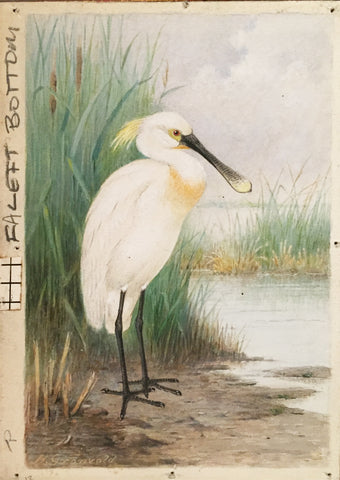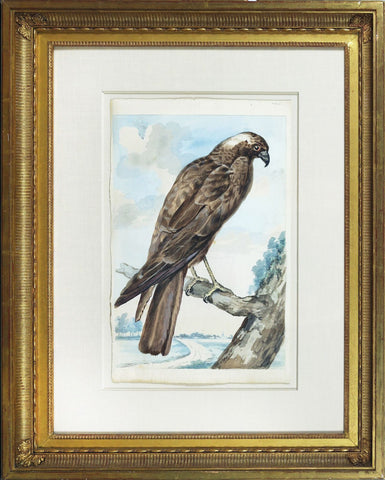
Henrik Grönvold (Danish, 1858 –1940), Platalea Leucorodia (White Spoonbill)
Henrik Grönvold (Danish, 1858 –1940)
“Platalea Leucorodia (White Spoonbill)”
Prepared for Plate III W.H. Hudson and L. Gardiner, Rare, Vanishing and Lost British Birds (1923)
Pencil and watercolor heightened with gouache, some with touches of gum Arabic on card
Signed ‘H Gronvold’ l.l.
1922-1923
Paper size: 7 1/8 x 5 in.
Provenance: Anonymous sale; Christie’s, London, 17 March 1999, lot 149, where purchased by the present owner.
“Of this strikingly handsome species, Sir Thomas Browne has the following notice in his Account of the Birds found in Norfolk: ‘The Platea, or Shovelard, which build on the tops of high trees. They formerly built in the hernery at Claxton and Reedham, now at Trimley in Suffolk. They come in March, and are shot by fowlers, not for their meat, but for the handsomeness of the same; remarkable in their white colour, copped crown, and spoon- or spatule-like bill.’
The date of this record is 1678, and shows that the passion for killing things, merely because they are beautiful when alive, is not a growth of the present time. Probably the bird continued to breed a few years longer in England—perhaps to the end of the seventeenth century.
It is possible that some readers of this paper who are unacquainted with ornithological literature, will be surprised to learn that the Spoonbill — this beautiful bird of an unfamiliar and exotic appearance was ever a veritable member of the British fauna; and it is true that, with the exception of the passage quoted, no mention is made of the Spoonbill by any of the old English writers whose works have come down to us. Some naturalists have even expressed the belief that the ‘Platea or Shovelard’ of Sir Thomas Browne was the Shoveller Duck. This point has now been cleared up, and Mr. J. E. Harting has found accounts in old records of breeding-places of the Spoonbill in other parts of England. In the Zoologist , 1877, p. 425, he tells us of one which existed in the woods at East Dean, near Chichester, in 1570. He made the still more interesting discovery that Spoonbills had a breeding place, or heronry, in the Bishop of London’s park, or grounds, at Fulham. It appears that in the 14th year of the reign of Henry VIII., the bishop brought an action of trespass against a grazier for taking Herons and Spoonbills from the trees, which had been reserved.
An account of the trial of the case, in which the grazier was happily worsted, is given in the Zoologist, 1886, p. 81.
Harting adds that Norden, who himself lived at Fulham, tells us in his Speculum Britannice (1593), that ‘the name of the place was anciently written Fullenham, or Fullonham, which (as Master Camden taketh it) signifyeth volucrum domus , the habitacle of birdes, or the place of fowles, Fullon and Fuglas in the Saxon toong do signifie fowles, and ham or hame as much as home in our toong.’
Fulham keeps its name, also its Bishop’s Palace, but it is no longer the ‘habitacle of birdes.’ Selby (1837) mentions that a pair of Spoonbills were sent to him which had been shot in May in Norfolk, and remarks that they would probably have bred in the county if they had been left alive. Doubtless the Spoonbill would have bred a hundred times since its extinction as a British species if the stray visitors that remain till early summer had been spared. Two, for example, were shot in May 1889 on the Kentish coast, where they continue to appear now and again; one was sold to a collector for £7, and the second was added to another collection. It was of no account that the law forbade such killing and such possession. A third is mentioned in Mr. Ticehurst’s Birds of Kent, as shot on Romney Marsh in June 1891. He adds that one of the Watchers of the Royal Society for the Protection of Birds sees three or four Spoon¬ bills almost every spring. ‘One day in the spring of 1897 he saw two adult birds on the sands at Littlestone, where, owing to his friendly presence, they were safe from molestation.’ If Dungeness and the marshes could be protected for a sufficiently long period, possibly Spoonbills might not only be seen, but might even remain to breed.
An effort has been made of late years to protect them in the districts where they were last known to breed and which they revisit every spring.
‘Probably visitors to Breydon for centuries; records go back to 1774. Indeed there is nothing impossible in the supposition that at the beginning of the eighteenth century they were still breeders in its vicinity and came there for their daily food to this large tidal Broad.’—J. H. Gurney, British Birds, X. 239.
‘The Spoonbill was formerly a regular summer visitor to this country, and bred in the marshes of Norfolk and Suffolk. They were exterminated at the close of the seventeenth century. The last records of their breeding in England may be found in Sir Thomas Browne’s Notes on the Birds of Norfolk, who described them as breeding about 1670 in Trimley in Suffolk, and as formerly having bred at Claxton, near Norwich, and Reedham, near Yarmouth. In spite of the persecution which caused them to cease to breed in this country two hundred years ago, the hereditary instinct which leads these birds to migrate to our country in spring does not appear to have wholly died out, and scarcely a year passes without a few birds being seen, most of which, the Birds Protection Act notwithstanding, fall victims to the insatiable desire to acquire specimens of rare British birds.’— Seebohm’s British Birds.
‘Now that the Breydon tidal mud is under the eye of a watcher. Spoonbills wisely halt on this safe water when their migration route carries them over East Anglia; if they wander further afield the protection laws seldom save them from the ‘sportsman.’—T. A. Coward’s Birds of the British Isles.
‘Formerly bred in East Anglia, Sussex, Middlesex, Pembroke and elsewhere. Passage migrant in Norfolk and Kent, vagrant elsewhere. A few visit Norfolk annually. To south coast, especially Hants and Devon, fairly frequent, usually in autumn.’ —Witherby’s Handbook, II. 194.”
HENRIK GRÖNVOLD (DANISH, 1858 –1940)
Henrik Grönvold studied drawing in Copenhagen and worked first as a draughtsman of the Royal Danish Army’s artillery and an illustrator at the Biological Research Station of Copenhagen. In 1892, Grönvold left Denmark for London, employed at the Natural History Museum preparing anatomical specimens. There he became a skilled taxidermist and established a reputation as an artist. He was employed at the Museum until 1895 when he accompanied William Ogilvie-Grant on an expedition to the Salvage Islands. After this expedition, Grönvold worked at the Museum in an unofficial capacity as an artist for decades and only left London to attend an ornithological congress in Berlin.
Grönvold’s illustrations mainly appeared in scientific periodicals such as the Proceedings and Transactions of the Zoological Society, The Ibis, and the Avicultural Magazine. In these publications, he drew plates for William Ogilvie-Grant, George Albert Boulenger, and Michael Rogers Oldfield Thomas, among others. Grönvold also completed numerous plates for Walter Rothschild, many of which appeared in Rothschild’s journal Novitates Zoologicae. Grönvold mostly illustrated birds and eggs, rare and newly discovered species from many parts of the world, and mostly worked in lithographs.
Among the books, Grönvold illustrated is George Shelley’s Birds of Africa, which contained 57 plates, many of which had not been illustrated before. He illustrated W. L. Buller’s books on the birds of New Zealand, Brabourne’s Birds of South America, Henry Eliot Howard’s The British Warblers (1907–14), Charles William Beebe’s A Monograph of the Pheasants (1918–22), and Herbert Christopher Robinson’s The Birds of the Malay Peninsula (1929–76). He completed 600 hand-colored plates for twelve volumes of The Birds of Australia (1910–27) by Gregory Macalister Mathews. Grönvold subsequently provided numerous illustrations for Mathews’ The Birds of Norfolk and Lord Howe Islands … (1928) and A Supplement to The Birds of Norfolk and Lord Howe Islands … (1936).
ORIGINAL WATERCOLORS FOR RARE, VANISHING
AND LOST BRITISH BIRDS
by Henrik Grönvold for William Henry Hudson
William Henry Hudson (1841-1922) was a naturalist, author, and staunch advocate for avian preservation and conservancy. Hudson’s lifelong commitment to protecting the environment stemmed from his youth in Argentina, where he marveled at the beauty of nature, spending endless hours watching the drama of forest and field unfold before him. This idyllic upbringing was beautifully penned in the artist’s work Far Away and Long Ago (1918), which remains a cult favorite amongst many novelists, including Ernest Hemingway, who wrote that Hudson’s book was a must-read for any young writer.
Hudson gravitated to studying birds, which guided his life’s work as an ornithologist and author of numerous tomes on the subject. When he settled in England in 1874, he joined the numerous societies for naturalists of the period and became a founding member of the Royal Society to protect birds.
In 1894, W.H. Hudson produced a leaflet titled Lost British Birds produced for Society for the Protection of Birds. Its purpose was to shed light on thirteen “lost” birds which he defined as those “which no longer breed in this country and visit our shores only as rare stragglers, or, bi-annually, in their migrations to and from their breeding areas on the continent Europe,” to concretely show the effect of industrialism, game hunting, and fashion on the sustainability of certain bird species. This pamphlet was illustrated with 15 rudimentary black and white line drawings by A.D. McCormick. Almost immediately after producing his brochure, Hudson began to collect notes for a future publication that would elaborate upon and update facts on endangered and extinct bird species.
Hudson spent the nineteen-teens and early twenties preparing his next publication. When his notes were organized, and he tapped the celebrated ornithological painter Henrik Grönvold (1858-1940) to produce a sophisticated full-color composition for each bird he intended to discuss at length. However, Hudson suddenly died in 1922 before the publication could come to fruition. Hudson’s colleague, Linda Gardiner, pushed the project forward to see it through in 1923.
Please feel free to contact us with questions by phone at 215.735.8811,
or by email at loricohen@aradergalleries.
We Also Recommend





